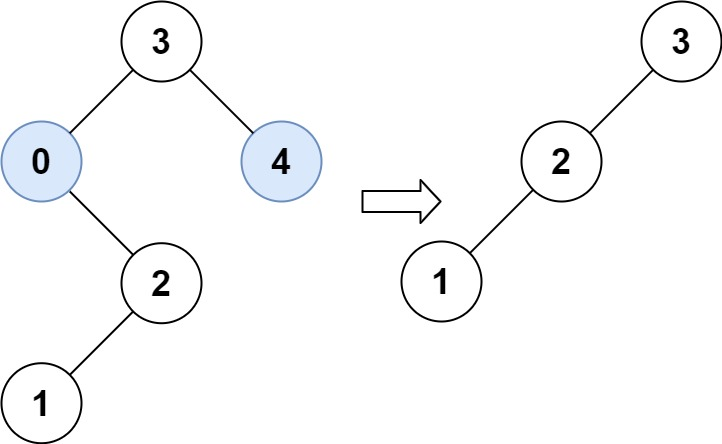给你二叉搜索树的根节点 root ,同时给定最小边界low 和最大边界 high。通过修剪二叉搜索树,使得所有节点的值在[low, high]中。修剪树不应该改变保留在树中的元素的相对结构(即,如果没有被移除,原有的父代子代关系都应当保留)。 可以证明,存在唯一的答案。
所以结果应当返回修剪好的二叉搜索树的新的根节点。注意,根节点可能会根据给定的边界发生改变。
示例 1:

输入:root = [1,0,2], low = 1, high = 2
输出:[1,null,2]
示例 2:

输入:root = [3,0,4,null,2,null,null,1], low = 1, high = 3
输出:[3,2,null,1]
示例 3:
输入:root = [1], low = 1, high = 2
输出:[1]
示例 4:
输入:root = [1,null,2], low = 1, high = 3
输出:[1,null,2]
示例 5:
输入:root = [1,null,2], low = 2, high = 4
输出:[2]
提示:
树中节点数在范围 [1, 104] 内
0 <= Node.val <= 104
树中每个节点的值都是唯一的
题目数据保证输入是一棵有效的二叉搜索树
0 <= low <= high <= 104
来源:力扣(LeetCode)
链接:https://leetcode-cn.com/problems/trim-a-binary-search-tree
参考:
python
# 0669-修剪二叉搜索树
class Solution1:
def trimBST(self, root: TreeNode, low: int, high: int) -> TreeNode:
"""
递归
:param root:
:param low:
:param high:
:return:
"""
if not root:
return None
# 寻找符合区间的节点 [low, high]
if root.val < low:
right = self.trimBST(root.right, low, high)
return right
if root.val > high:
left = self.trimBST(root.left, low, high)
return left
# 各自接入符合条件的左右孩子
root.left = self.trimBST(root.left, low, high)
root.right = self.trimBST(root.right, low, high)
return root
class Solution2:
def trimBST(self, root: TreeNode, low: int, high: int) -> TreeNode:
"""
迭代
:param root:
:param low:
:param high:
:return:
"""
if not root:
return None
# 处理头结点,root移动到[low, high]范围内
while root and (root.val < low or root.val > high):
# 小于low的往右走
if root.val < low:
root = root.right
# 大于high的往左走
else:
root = root.left
cur = root
# root已经在区间内,处理左孩子小于low的情况
while cur:
while cur.left and cur.left.val < low:
cur.left = cur.left.right
cur = cur.left
cur = root
# root已经在区间内,处理右孩子大于high的情况
while cur:
while cur.right and cur.right.val > high:
cur.right = cur.right.left
cur = cur.right
return root
golang
package binaryTree
// 递归
func trimBST(root *TreeNode, low int, high int) *TreeNode {
if root == nil {
return nil
}
if root.Val < low {
right := trimBST(root.Right, low, high)
return right
}
if root.Val > high {
left := trimBST(root.Left, low, high)
return left
}
root.Left = trimBST(root.Left, low, high)
root.Right = trimBST(root.Right, low, high)
return root
}
// 迭代
func trimBST2(root *TreeNode, low int, high int) *TreeNode {
if root == nil {
return nil
}
// 处理root,让root移动到[low, high]
for root != nil && (root.Val < low || root.Val > high) {
if root.Val < low {
root = root.Right
} else {
root = root.Left
}
}
// 此时root已经在区间内,处理左孩子元素小于low
cur := root
for cur != nil {
for cur.Left != nil && cur.Left.Val < low {
cur.Left = cur.Left.Right
}
cur = cur.Left
}
// 此时root已经在区间内,处理右孩子元素大于high
cur = root
for cur != nil {
for cur.Right != nil && cur.Right.Val > high {
cur.Right = cur.Right.Left
}
cur = cur.Right
}
return root
}